Financial Management Report: Plaggio Limited Company Analysis
VerifiedAdded on 2021/04/17
|21
|3940
|118
Report
AI Summary
This report provides a detailed financial analysis of Plaggio Limited, focusing on investment appraisal techniques. It evaluates three investment tenders using Net Present Value (NPV), Internal Rate of Return (IRR), payback period, and average accounting return to determine the best investment option. The report also discusses the company's capital structure, the weighted average cost of capital (WACC), and factors affecting the cost of capital. Furthermore, it critically examines different ways capital can be raised by an organization, offering recommendations and conclusions based on the financial data and analysis. The report concludes that none of the tenders are recommended but if a decision has to be made, Tender A is more preferable.

RUNNING HEAD: Financial management 1 | P a g e
Name of the student
Topic- Financial management
University name-
Name of the student
Topic- Financial management
University name-
Paraphrase This Document
Need a fresh take? Get an instant paraphrase of this document with our AI Paraphraser
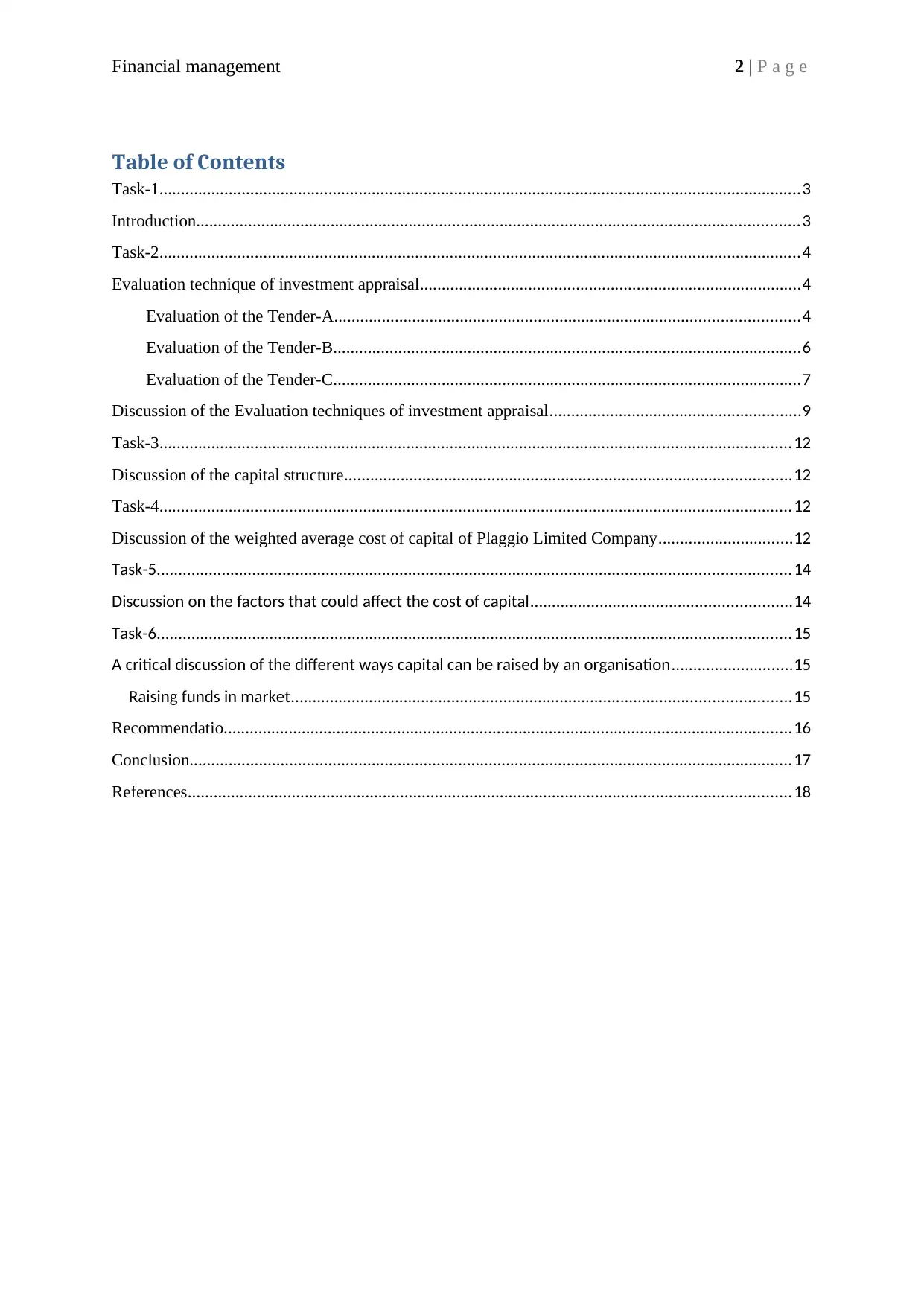
Financial management 2 | P a g e
Table of Contents
Task-1....................................................................................................................................................3
Introduction...........................................................................................................................................3
Task-2....................................................................................................................................................4
Evaluation technique of investment appraisal........................................................................................4
Evaluation of the Tender-A...........................................................................................................4
Evaluation of the Tender-B............................................................................................................6
Evaluation of the Tender-C............................................................................................................7
Discussion of the Evaluation techniques of investment appraisal..........................................................9
Task-3..................................................................................................................................................12
Discussion of the capital structure.......................................................................................................12
Task-4..................................................................................................................................................12
Discussion of the weighted average cost of capital of Plaggio Limited Company...............................12
Task-5..................................................................................................................................................14
Discussion on the factors that could affect the cost of capital............................................................14
Task-6..................................................................................................................................................15
A critical discussion of the different ways capital can be raised by an organisation............................15
Raising funds in market...................................................................................................................15
Recommendatio...................................................................................................................................16
Conclusion...........................................................................................................................................17
References...........................................................................................................................................18
Table of Contents
Task-1....................................................................................................................................................3
Introduction...........................................................................................................................................3
Task-2....................................................................................................................................................4
Evaluation technique of investment appraisal........................................................................................4
Evaluation of the Tender-A...........................................................................................................4
Evaluation of the Tender-B............................................................................................................6
Evaluation of the Tender-C............................................................................................................7
Discussion of the Evaluation techniques of investment appraisal..........................................................9
Task-3..................................................................................................................................................12
Discussion of the capital structure.......................................................................................................12
Task-4..................................................................................................................................................12
Discussion of the weighted average cost of capital of Plaggio Limited Company...............................12
Task-5..................................................................................................................................................14
Discussion on the factors that could affect the cost of capital............................................................14
Task-6..................................................................................................................................................15
A critical discussion of the different ways capital can be raised by an organisation............................15
Raising funds in market...................................................................................................................15
Recommendatio...................................................................................................................................16
Conclusion...........................................................................................................................................17
References...........................................................................................................................................18
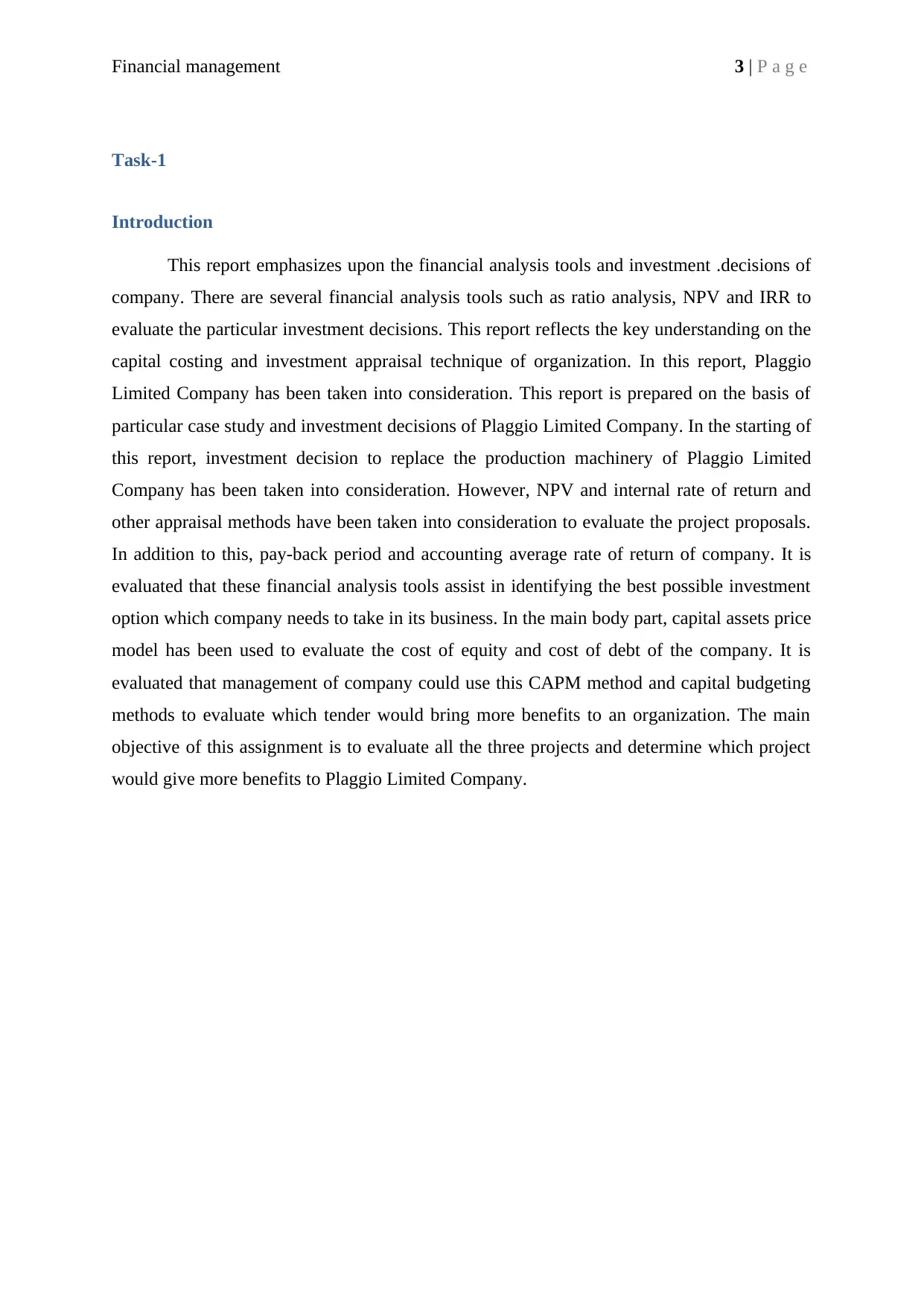
Financial management 3 | P a g e
Task-1
Introduction
This report emphasizes upon the financial analysis tools and investment .decisions of
company. There are several financial analysis tools such as ratio analysis, NPV and IRR to
evaluate the particular investment decisions. This report reflects the key understanding on the
capital costing and investment appraisal technique of organization. In this report, Plaggio
Limited Company has been taken into consideration. This report is prepared on the basis of
particular case study and investment decisions of Plaggio Limited Company. In the starting of
this report, investment decision to replace the production machinery of Plaggio Limited
Company has been taken into consideration. However, NPV and internal rate of return and
other appraisal methods have been taken into consideration to evaluate the project proposals.
In addition to this, pay-back period and accounting average rate of return of company. It is
evaluated that these financial analysis tools assist in identifying the best possible investment
option which company needs to take in its business. In the main body part, capital assets price
model has been used to evaluate the cost of equity and cost of debt of the company. It is
evaluated that management of company could use this CAPM method and capital budgeting
methods to evaluate which tender would bring more benefits to an organization. The main
objective of this assignment is to evaluate all the three projects and determine which project
would give more benefits to Plaggio Limited Company.
Task-1
Introduction
This report emphasizes upon the financial analysis tools and investment .decisions of
company. There are several financial analysis tools such as ratio analysis, NPV and IRR to
evaluate the particular investment decisions. This report reflects the key understanding on the
capital costing and investment appraisal technique of organization. In this report, Plaggio
Limited Company has been taken into consideration. This report is prepared on the basis of
particular case study and investment decisions of Plaggio Limited Company. In the starting of
this report, investment decision to replace the production machinery of Plaggio Limited
Company has been taken into consideration. However, NPV and internal rate of return and
other appraisal methods have been taken into consideration to evaluate the project proposals.
In addition to this, pay-back period and accounting average rate of return of company. It is
evaluated that these financial analysis tools assist in identifying the best possible investment
option which company needs to take in its business. In the main body part, capital assets price
model has been used to evaluate the cost of equity and cost of debt of the company. It is
evaluated that management of company could use this CAPM method and capital budgeting
methods to evaluate which tender would bring more benefits to an organization. The main
objective of this assignment is to evaluate all the three projects and determine which project
would give more benefits to Plaggio Limited Company.
⊘ This is a preview!⊘
Do you want full access?
Subscribe today to unlock all pages.

Trusted by 1+ million students worldwide
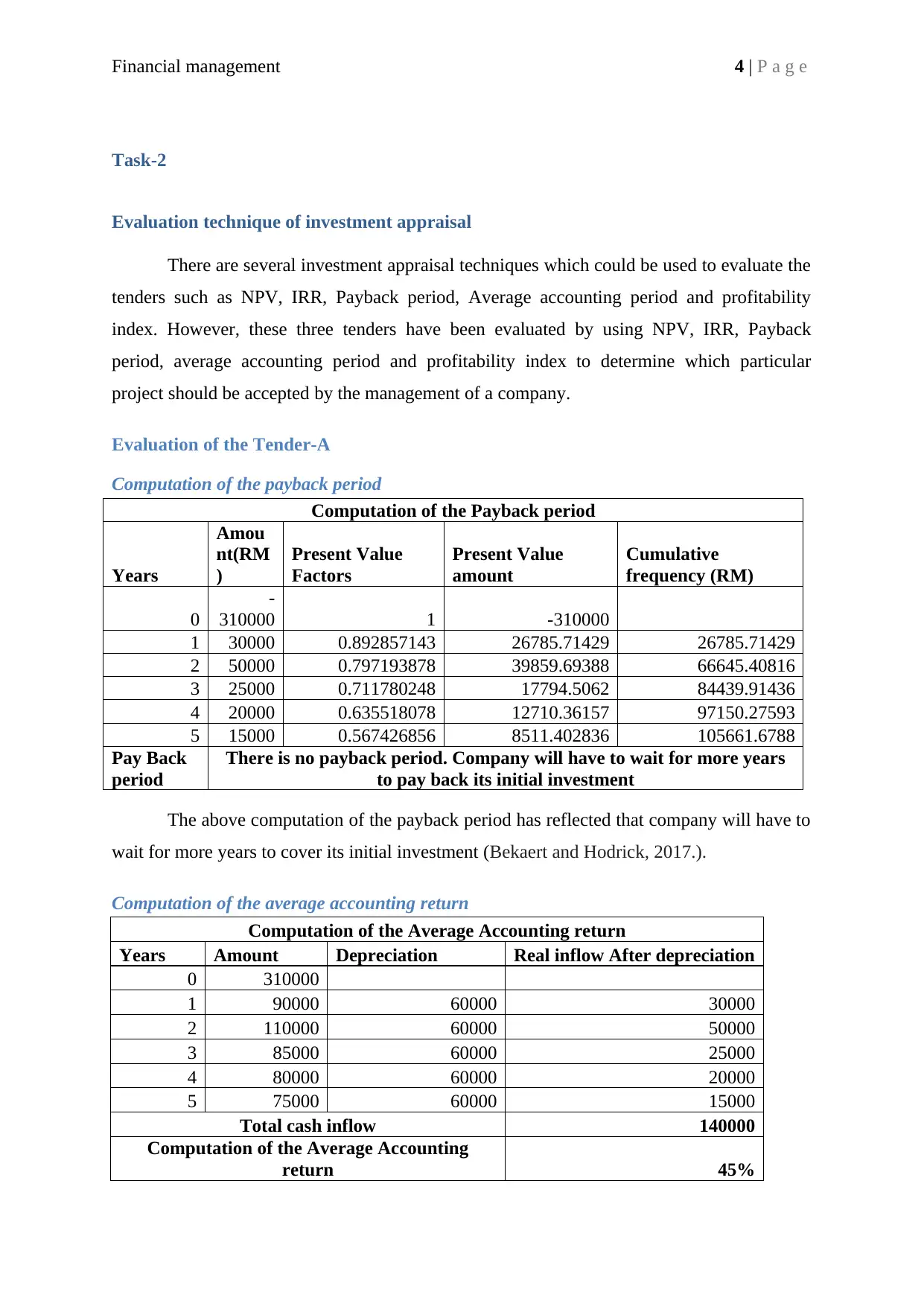
Financial management 4 | P a g e
Task-2
Evaluation technique of investment appraisal
There are several investment appraisal techniques which could be used to evaluate the
tenders such as NPV, IRR, Payback period, Average accounting period and profitability
index. However, these three tenders have been evaluated by using NPV, IRR, Payback
period, average accounting period and profitability index to determine which particular
project should be accepted by the management of a company.
Evaluation of the Tender-A
Computation of the payback period
Computation of the Payback period
Years
Amou
nt(RM
)
Present Value
Factors
Present Value
amount
Cumulative
frequency (RM)
0
-
310000 1 -310000
1 30000 0.892857143 26785.71429 26785.71429
2 50000 0.797193878 39859.69388 66645.40816
3 25000 0.711780248 17794.5062 84439.91436
4 20000 0.635518078 12710.36157 97150.27593
5 15000 0.567426856 8511.402836 105661.6788
Pay Back
period
There is no payback period. Company will have to wait for more years
to pay back its initial investment
The above computation of the payback period has reflected that company will have to
wait for more years to cover its initial investment (Bekaert and Hodrick, 2017.).
Computation of the average accounting return
Computation of the Average Accounting return
Years Amount Depreciation Real inflow After depreciation
0 310000
1 90000 60000 30000
2 110000 60000 50000
3 85000 60000 25000
4 80000 60000 20000
5 75000 60000 15000
Total cash inflow 140000
Computation of the Average Accounting
return 45%
Task-2
Evaluation technique of investment appraisal
There are several investment appraisal techniques which could be used to evaluate the
tenders such as NPV, IRR, Payback period, Average accounting period and profitability
index. However, these three tenders have been evaluated by using NPV, IRR, Payback
period, average accounting period and profitability index to determine which particular
project should be accepted by the management of a company.
Evaluation of the Tender-A
Computation of the payback period
Computation of the Payback period
Years
Amou
nt(RM
)
Present Value
Factors
Present Value
amount
Cumulative
frequency (RM)
0
-
310000 1 -310000
1 30000 0.892857143 26785.71429 26785.71429
2 50000 0.797193878 39859.69388 66645.40816
3 25000 0.711780248 17794.5062 84439.91436
4 20000 0.635518078 12710.36157 97150.27593
5 15000 0.567426856 8511.402836 105661.6788
Pay Back
period
There is no payback period. Company will have to wait for more years
to pay back its initial investment
The above computation of the payback period has reflected that company will have to
wait for more years to cover its initial investment (Bekaert and Hodrick, 2017.).
Computation of the average accounting return
Computation of the Average Accounting return
Years Amount Depreciation Real inflow After depreciation
0 310000
1 90000 60000 30000
2 110000 60000 50000
3 85000 60000 25000
4 80000 60000 20000
5 75000 60000 15000
Total cash inflow 140000
Computation of the Average Accounting
return 45%
Paraphrase This Document
Need a fresh take? Get an instant paraphrase of this document with our AI Paraphraser

Financial management 5 | P a g e
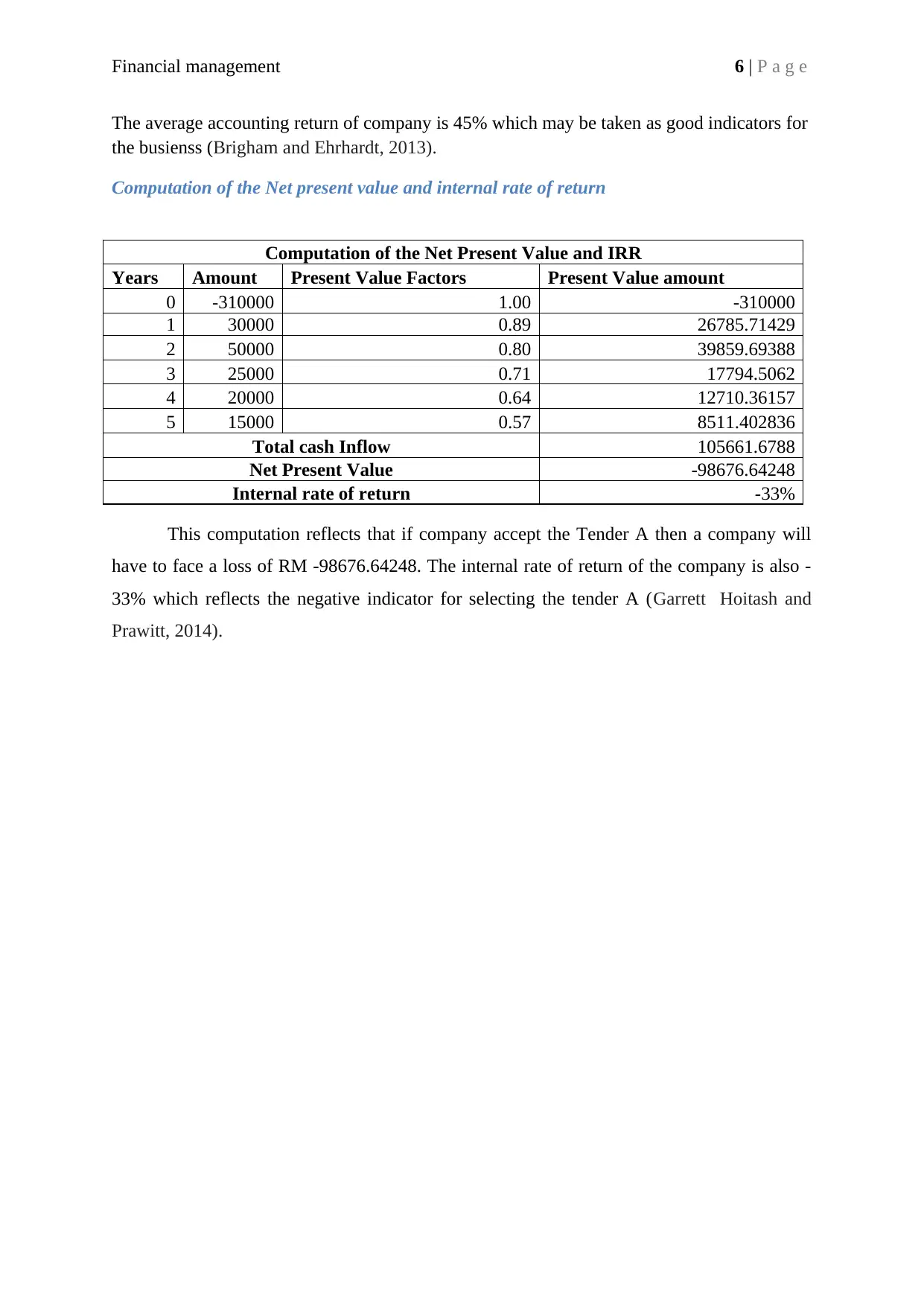
Financial management 6 | P a g e
The average accounting return of company is 45% which may be taken as good indicators for
the busienss (Brigham and Ehrhardt, 2013).
Computation of the Net present value and internal rate of return
Computation of the Net Present Value and IRR
Years Amount Present Value Factors Present Value amount
0 -310000 1.00 -310000
1 30000 0.89 26785.71429
2 50000 0.80 39859.69388
3 25000 0.71 17794.5062
4 20000 0.64 12710.36157
5 15000 0.57 8511.402836
Total cash Inflow 105661.6788
Net Present Value -98676.64248
Internal rate of return -33%
This computation reflects that if company accept the Tender A then a company will
have to face a loss of RM -98676.64248. The internal rate of return of the company is also -
33% which reflects the negative indicator for selecting the tender A (Garrett Hoitash and
Prawitt, 2014).
The average accounting return of company is 45% which may be taken as good indicators for
the busienss (Brigham and Ehrhardt, 2013).
Computation of the Net present value and internal rate of return
Computation of the Net Present Value and IRR
Years Amount Present Value Factors Present Value amount
0 -310000 1.00 -310000
1 30000 0.89 26785.71429
2 50000 0.80 39859.69388
3 25000 0.71 17794.5062
4 20000 0.64 12710.36157
5 15000 0.57 8511.402836
Total cash Inflow 105661.6788
Net Present Value -98676.64248
Internal rate of return -33%
This computation reflects that if company accept the Tender A then a company will
have to face a loss of RM -98676.64248. The internal rate of return of the company is also -
33% which reflects the negative indicator for selecting the tender A (Garrett Hoitash and
Prawitt, 2014).
⊘ This is a preview!⊘
Do you want full access?
Subscribe today to unlock all pages.

Trusted by 1+ million students worldwide
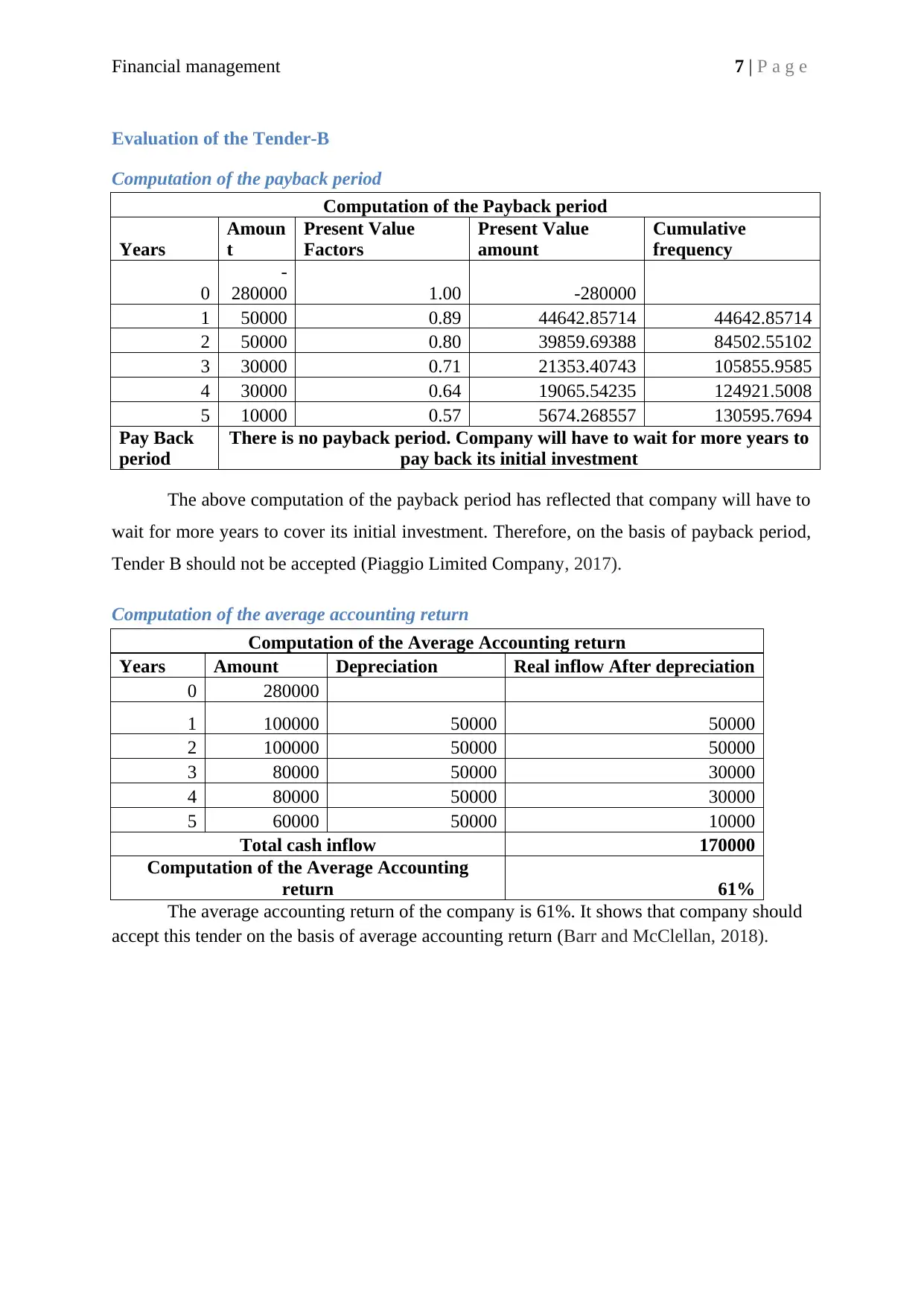
Financial management 7 | P a g e
Evaluation of the Tender-B
Computation of the payback period
Computation of the Payback period
Years
Amoun
t
Present Value
Factors
Present Value
amount
Cumulative
frequency
0
-
280000 1.00 -280000
1 50000 0.89 44642.85714 44642.85714
2 50000 0.80 39859.69388 84502.55102
3 30000 0.71 21353.40743 105855.9585
4 30000 0.64 19065.54235 124921.5008
5 10000 0.57 5674.268557 130595.7694
Pay Back
period
There is no payback period. Company will have to wait for more years to
pay back its initial investment
The above computation of the payback period has reflected that company will have to
wait for more years to cover its initial investment. Therefore, on the basis of payback period,
Tender B should not be accepted (Piaggio Limited Company, 2017).
Computation of the average accounting return
Computation of the Average Accounting return
Years Amount Depreciation Real inflow After depreciation
0 280000
1 100000 50000 50000
2 100000 50000 50000
3 80000 50000 30000
4 80000 50000 30000
5 60000 50000 10000
Total cash inflow 170000
Computation of the Average Accounting
return 61%
The average accounting return of the company is 61%. It shows that company should
accept this tender on the basis of average accounting return (Barr and McClellan, 2018).
Evaluation of the Tender-B
Computation of the payback period
Computation of the Payback period
Years
Amoun
t
Present Value
Factors
Present Value
amount
Cumulative
frequency
0
-
280000 1.00 -280000
1 50000 0.89 44642.85714 44642.85714
2 50000 0.80 39859.69388 84502.55102
3 30000 0.71 21353.40743 105855.9585
4 30000 0.64 19065.54235 124921.5008
5 10000 0.57 5674.268557 130595.7694
Pay Back
period
There is no payback period. Company will have to wait for more years to
pay back its initial investment
The above computation of the payback period has reflected that company will have to
wait for more years to cover its initial investment. Therefore, on the basis of payback period,
Tender B should not be accepted (Piaggio Limited Company, 2017).
Computation of the average accounting return
Computation of the Average Accounting return
Years Amount Depreciation Real inflow After depreciation
0 280000
1 100000 50000 50000
2 100000 50000 50000
3 80000 50000 30000
4 80000 50000 30000
5 60000 50000 10000
Total cash inflow 170000
Computation of the Average Accounting
return 61%
The average accounting return of the company is 61%. It shows that company should
accept this tender on the basis of average accounting return (Barr and McClellan, 2018).
Paraphrase This Document
Need a fresh take? Get an instant paraphrase of this document with our AI Paraphraser
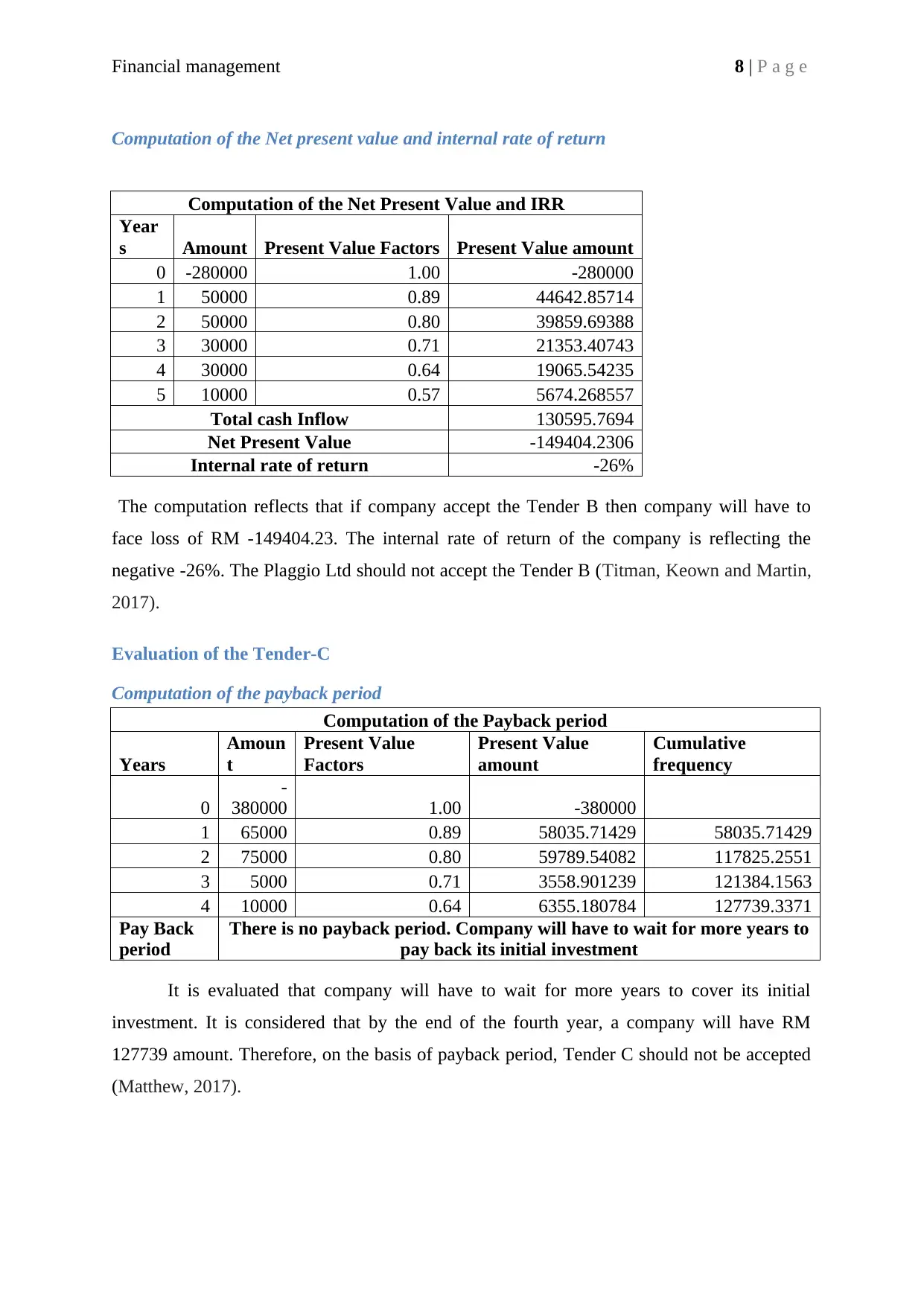
Financial management 8 | P a g e
Computation of the Net present value and internal rate of return
Computation of the Net Present Value and IRR
Year
s Amount Present Value Factors Present Value amount
0 -280000 1.00 -280000
1 50000 0.89 44642.85714
2 50000 0.80 39859.69388
3 30000 0.71 21353.40743
4 30000 0.64 19065.54235
5 10000 0.57 5674.268557
Total cash Inflow 130595.7694
Net Present Value -149404.2306
Internal rate of return -26%
The computation reflects that if company accept the Tender B then company will have to
face loss of RM -149404.23. The internal rate of return of the company is reflecting the
negative -26%. The Plaggio Ltd should not accept the Tender B (Titman, Keown and Martin,
2017).
Evaluation of the Tender-C
Computation of the payback period
Computation of the Payback period
Years
Amoun
t
Present Value
Factors
Present Value
amount
Cumulative
frequency
0
-
380000 1.00 -380000
1 65000 0.89 58035.71429 58035.71429
2 75000 0.80 59789.54082 117825.2551
3 5000 0.71 3558.901239 121384.1563
4 10000 0.64 6355.180784 127739.3371
Pay Back
period
There is no payback period. Company will have to wait for more years to
pay back its initial investment
It is evaluated that company will have to wait for more years to cover its initial
investment. It is considered that by the end of the fourth year, a company will have RM
127739 amount. Therefore, on the basis of payback period, Tender C should not be accepted
(Matthew, 2017).
Computation of the Net present value and internal rate of return
Computation of the Net Present Value and IRR
Year
s Amount Present Value Factors Present Value amount
0 -280000 1.00 -280000
1 50000 0.89 44642.85714
2 50000 0.80 39859.69388
3 30000 0.71 21353.40743
4 30000 0.64 19065.54235
5 10000 0.57 5674.268557
Total cash Inflow 130595.7694
Net Present Value -149404.2306
Internal rate of return -26%
The computation reflects that if company accept the Tender B then company will have to
face loss of RM -149404.23. The internal rate of return of the company is reflecting the
negative -26%. The Plaggio Ltd should not accept the Tender B (Titman, Keown and Martin,
2017).
Evaluation of the Tender-C
Computation of the payback period
Computation of the Payback period
Years
Amoun
t
Present Value
Factors
Present Value
amount
Cumulative
frequency
0
-
380000 1.00 -380000
1 65000 0.89 58035.71429 58035.71429
2 75000 0.80 59789.54082 117825.2551
3 5000 0.71 3558.901239 121384.1563
4 10000 0.64 6355.180784 127739.3371
Pay Back
period
There is no payback period. Company will have to wait for more years to
pay back its initial investment
It is evaluated that company will have to wait for more years to cover its initial
investment. It is considered that by the end of the fourth year, a company will have RM
127739 amount. Therefore, on the basis of payback period, Tender C should not be accepted
(Matthew, 2017).
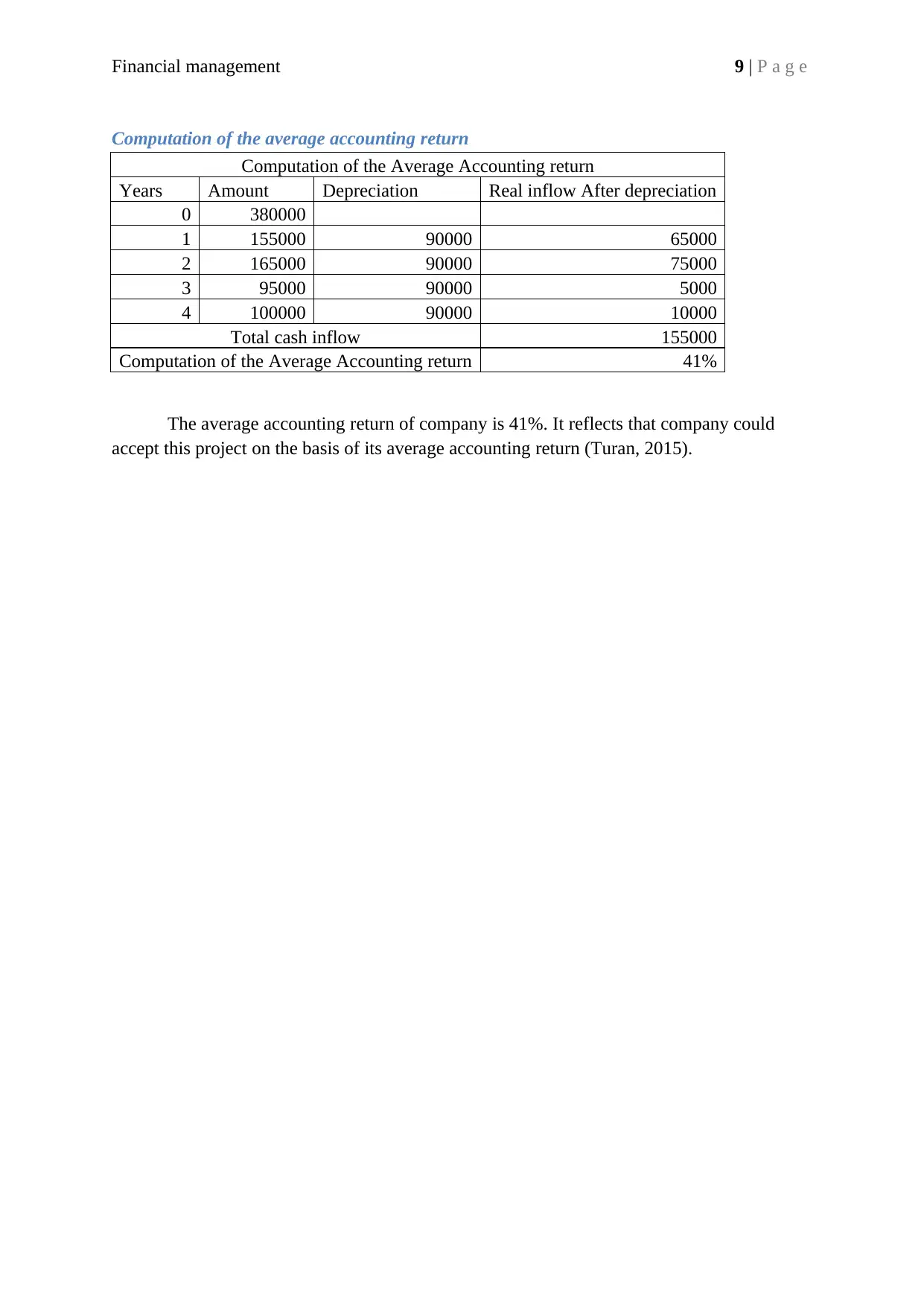
Financial management 9 | P a g e
Computation of the average accounting return
Computation of the Average Accounting return
Years Amount Depreciation Real inflow After depreciation
0 380000
1 155000 90000 65000
2 165000 90000 75000
3 95000 90000 5000
4 100000 90000 10000
Total cash inflow 155000
Computation of the Average Accounting return 41%
The average accounting return of company is 41%. It reflects that company could
accept this project on the basis of its average accounting return (Turan, 2015).
Computation of the average accounting return
Computation of the Average Accounting return
Years Amount Depreciation Real inflow After depreciation
0 380000
1 155000 90000 65000
2 165000 90000 75000
3 95000 90000 5000
4 100000 90000 10000
Total cash inflow 155000
Computation of the Average Accounting return 41%
The average accounting return of company is 41%. It reflects that company could
accept this project on the basis of its average accounting return (Turan, 2015).
⊘ This is a preview!⊘
Do you want full access?
Subscribe today to unlock all pages.

Trusted by 1+ million students worldwide
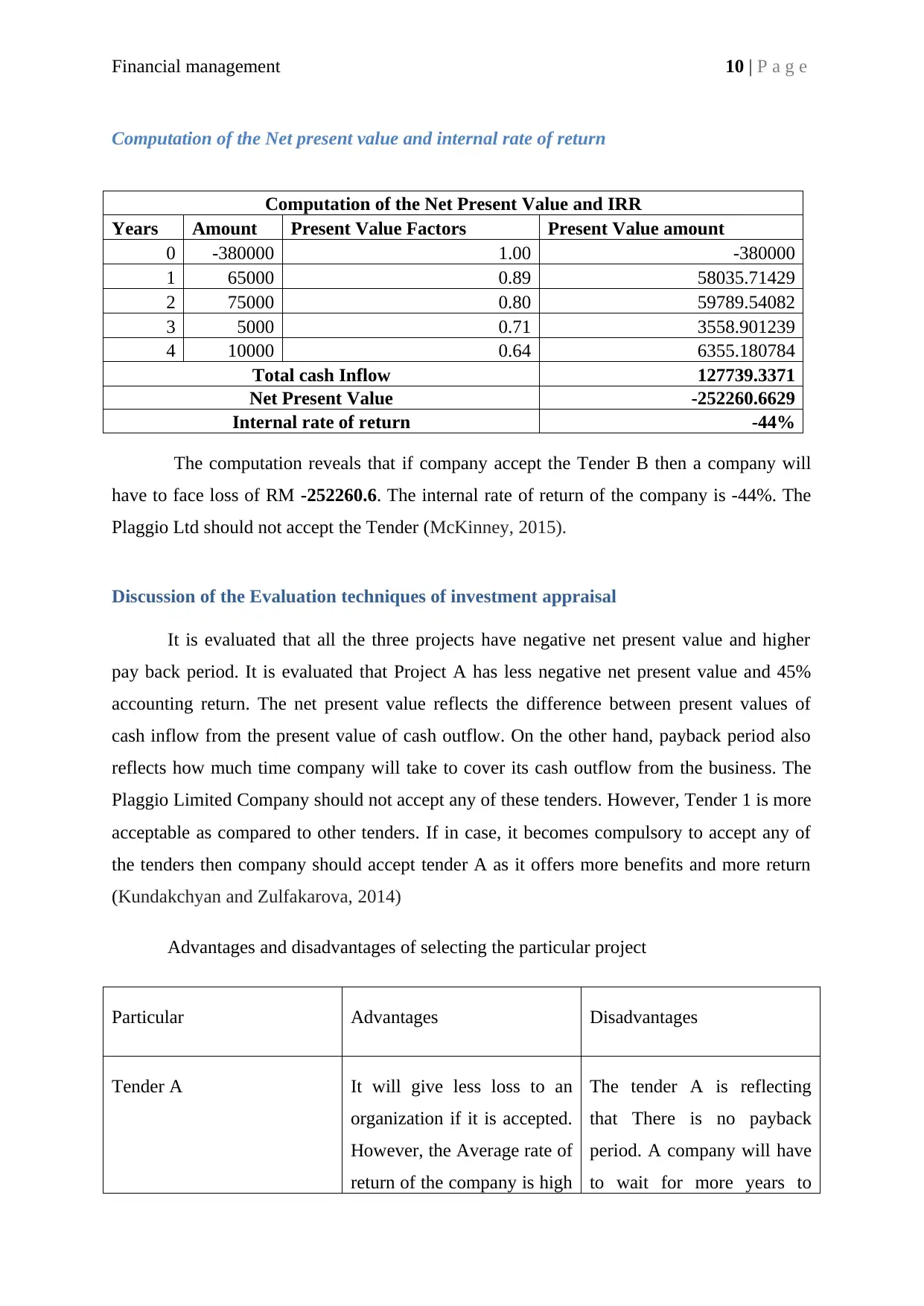
Financial management 10 | P a g e
Computation of the Net present value and internal rate of return
Computation of the Net Present Value and IRR
Years Amount Present Value Factors Present Value amount
0 -380000 1.00 -380000
1 65000 0.89 58035.71429
2 75000 0.80 59789.54082
3 5000 0.71 3558.901239
4 10000 0.64 6355.180784
Total cash Inflow 127739.3371
Net Present Value -252260.6629
Internal rate of return -44%
The computation reveals that if company accept the Tender B then a company will
have to face loss of RM -252260.6. The internal rate of return of the company is -44%. The
Plaggio Ltd should not accept the Tender (McKinney, 2015).
Discussion of the Evaluation techniques of investment appraisal
It is evaluated that all the three projects have negative net present value and higher
pay back period. It is evaluated that Project A has less negative net present value and 45%
accounting return. The net present value reflects the difference between present values of
cash inflow from the present value of cash outflow. On the other hand, payback period also
reflects how much time company will take to cover its cash outflow from the business. The
Plaggio Limited Company should not accept any of these tenders. However, Tender 1 is more
acceptable as compared to other tenders. If in case, it becomes compulsory to accept any of
the tenders then company should accept tender A as it offers more benefits and more return
(Kundakchyan and Zulfakarova, 2014)
Advantages and disadvantages of selecting the particular project
Particular Advantages Disadvantages
Tender A It will give less loss to an
organization if it is accepted.
However, the Average rate of
return of the company is high
The tender A is reflecting
that There is no payback
period. A company will have
to wait for more years to
Computation of the Net present value and internal rate of return
Computation of the Net Present Value and IRR
Years Amount Present Value Factors Present Value amount
0 -380000 1.00 -380000
1 65000 0.89 58035.71429
2 75000 0.80 59789.54082
3 5000 0.71 3558.901239
4 10000 0.64 6355.180784
Total cash Inflow 127739.3371
Net Present Value -252260.6629
Internal rate of return -44%
The computation reveals that if company accept the Tender B then a company will
have to face loss of RM -252260.6. The internal rate of return of the company is -44%. The
Plaggio Ltd should not accept the Tender (McKinney, 2015).
Discussion of the Evaluation techniques of investment appraisal
It is evaluated that all the three projects have negative net present value and higher
pay back period. It is evaluated that Project A has less negative net present value and 45%
accounting return. The net present value reflects the difference between present values of
cash inflow from the present value of cash outflow. On the other hand, payback period also
reflects how much time company will take to cover its cash outflow from the business. The
Plaggio Limited Company should not accept any of these tenders. However, Tender 1 is more
acceptable as compared to other tenders. If in case, it becomes compulsory to accept any of
the tenders then company should accept tender A as it offers more benefits and more return
(Kundakchyan and Zulfakarova, 2014)
Advantages and disadvantages of selecting the particular project
Particular Advantages Disadvantages
Tender A It will give less loss to an
organization if it is accepted.
However, the Average rate of
return of the company is high
The tender A is reflecting
that There is no payback
period. A company will have
to wait for more years to
Paraphrase This Document
Need a fresh take? Get an instant paraphrase of this document with our AI Paraphraser
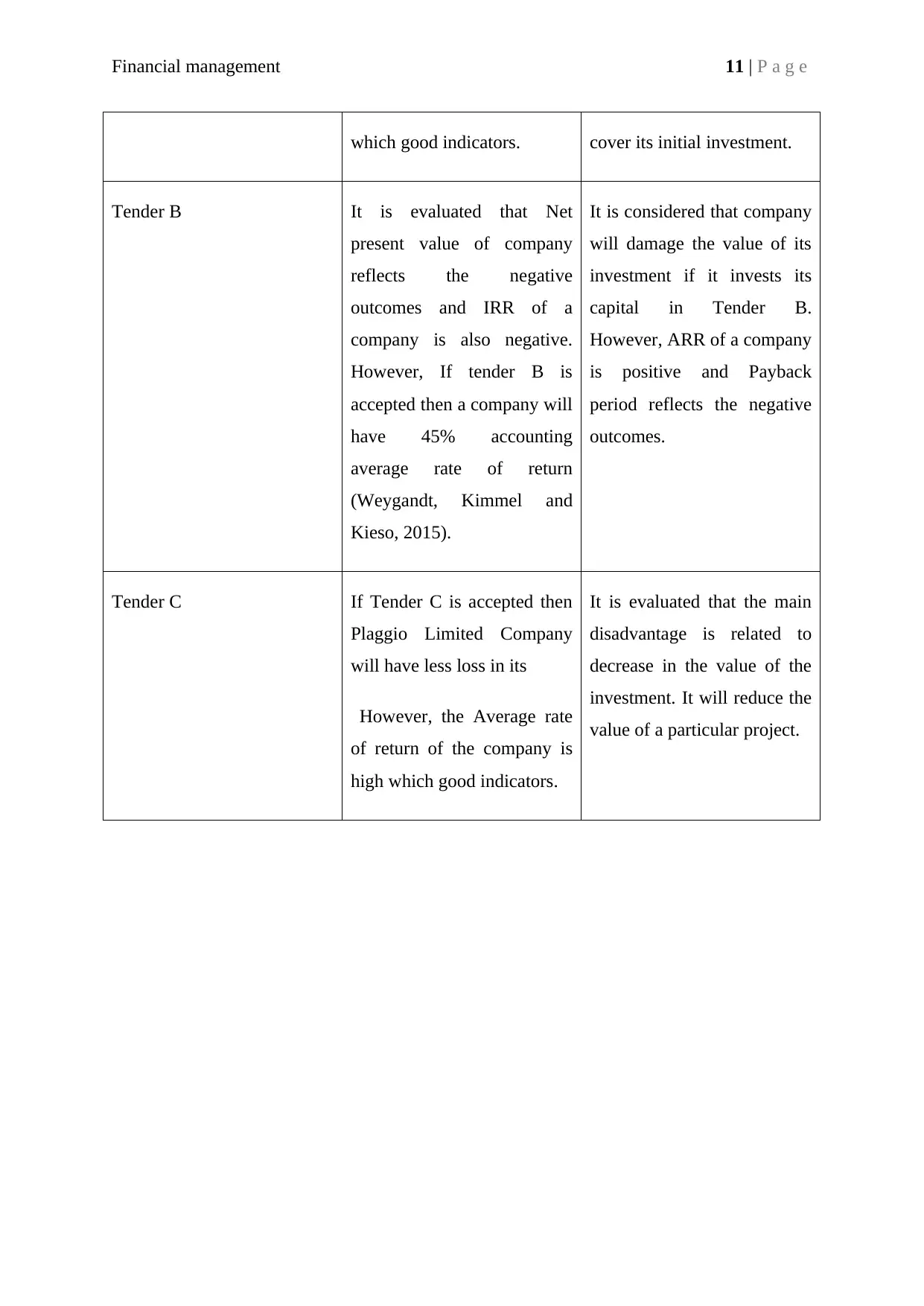
Financial management 11 | P a g e
which good indicators. cover its initial investment.
Tender B It is evaluated that Net
present value of company
reflects the negative
outcomes and IRR of a
company is also negative.
However, If tender B is
accepted then a company will
have 45% accounting
average rate of return
(Weygandt, Kimmel and
Kieso, 2015).
It is considered that company
will damage the value of its
investment if it invests its
capital in Tender B.
However, ARR of a company
is positive and Payback
period reflects the negative
outcomes.
Tender C If Tender C is accepted then
Plaggio Limited Company
will have less loss in its
However, the Average rate
of return of the company is
high which good indicators.
It is evaluated that the main
disadvantage is related to
decrease in the value of the
investment. It will reduce the
value of a particular project.
which good indicators. cover its initial investment.
Tender B It is evaluated that Net
present value of company
reflects the negative
outcomes and IRR of a
company is also negative.
However, If tender B is
accepted then a company will
have 45% accounting
average rate of return
(Weygandt, Kimmel and
Kieso, 2015).
It is considered that company
will damage the value of its
investment if it invests its
capital in Tender B.
However, ARR of a company
is positive and Payback
period reflects the negative
outcomes.
Tender C If Tender C is accepted then
Plaggio Limited Company
will have less loss in its
However, the Average rate
of return of the company is
high which good indicators.
It is evaluated that the main
disadvantage is related to
decrease in the value of the
investment. It will reduce the
value of a particular project.

Financial management 12 | P a g e
⊘ This is a preview!⊘
Do you want full access?
Subscribe today to unlock all pages.

Trusted by 1+ million students worldwide
1 out of 21
Related Documents
Your All-in-One AI-Powered Toolkit for Academic Success.
+13062052269
info@desklib.com
Available 24*7 on WhatsApp / Email
![[object Object]](/_next/static/media/star-bottom.7253800d.svg)
Unlock your academic potential
Copyright © 2020–2025 A2Z Services. All Rights Reserved. Developed and managed by ZUCOL.




